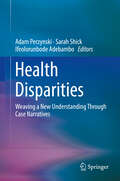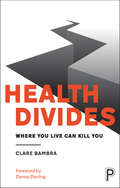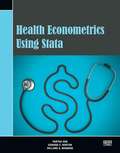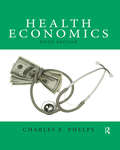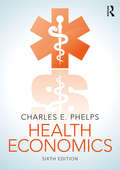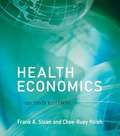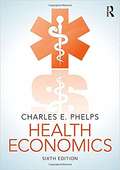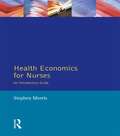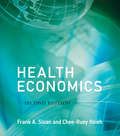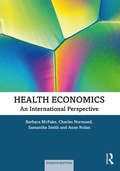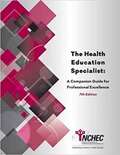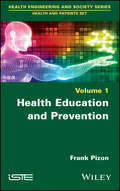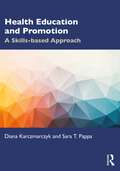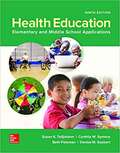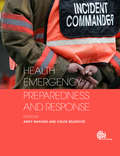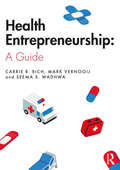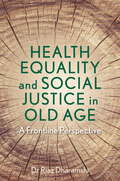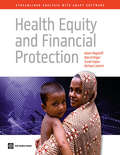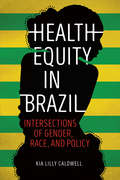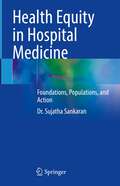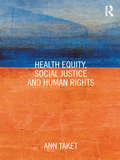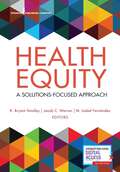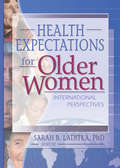- Table View
- List View
Health Disparities: Weaving a New Understanding Through Case Narratives
by Adam Perzynski Sarah Shick Ifeolorunbode AdebamboThis uniquely accessible volume challenges professionals to understand—and help correct—health disparities, both at the patient level and in their larger social contexts. Dedicated to eradicating this ongoing injustice, contributors focus on marginalized populations, the role of healthcare systems in perpetuating inequities, the need for deeper engagement and listening by professionals, and the need for advocacy within professional education and the political/policy arena. The compelling case narratives at the core of the book illustrate the interrelated biopsychosocial components of patients’ health problems and the gradations of learning needed for practitioners to address them effectively. The book’s tools for developing a health disparities curriculum include a selection of workshop exercises, facilitator resources, and a brief guide to writing effective case narratives. A sampling of the narratives: “Finding the Person in Patient-Centered Health Care” (race/ethnicity/culture). “The Annual Big Girl / Big Boy Exchange” (gender). “Just Give Me Narcan and Let Me Go” (poverty/addiction). “Everyone Called Him Crazy” (immigration). “Adrift in the System” (disability). “Aging out of Pediatrics” (mental illness and stigma). “Time to Leave” (LGBT) A work of profound compassion, Health Disparities will be of considerable interest to researchers and practitioners interested in public health, population health, health disparities, and related fields such as sociology, social work, and narrative medicine. Its wealth of educational features also makes it a quality training text. "I was impressed when I read Health Disparities: Weaving a New Understanding through Case Narratives. As a patient who has experienced unpleasant situations in health care, I was moved to see that it was emotional and personal for the writers. The book confirms for me that the time is now for change to take place in our health care systems. I see this book as a light that can shine bright in the darkest places of health care. The editors have assembled a powerful book that provides all health professionals with specific steps they can take towards addressing and then eventually eliminating health disparities. A few steps that I really connected with were improving critical awareness, delivering quality care, listening and empathizing with patients and families, and advocating for changes. I recommend that anyone interested in working to improve health care obtain a copy of this book—it’s filled with useful information that every medical professional should know. The book reminds me of a quote by Wayne Dyer, 'When you change the way you look at things, the things you look at change.'" -Delores Collins, Founder and Executive Director, A Vision of Change Incorporated, Certified Community Health Worker. Founder of The Greater Cleveland Community Health Workers Association.
Health Divides: Where You Live Can Kill You
by Clare BambraHIGHLY COMMENDED IN THE BMA BOOK AWARDS 2017 Americans live three years less than their counterparts in France or Sweden. Scottish men survive two years less than English men. Across Europe, women in the poorest communities live up to ten years less than those in the richest. Revealing gaps in life expectancy of up to 25 years between places just a few miles apart, this important book demonstrates that where you live can kill you. Clare Bambra, a leading expert in public health, draws on case studies from across the globe to examine the social, environmental, economic and political causes of these health inequalities, how they have evolved over time and what they are like today. Bambra concludes by considering how health divides might develop in the future and what should be done, so that where you live is not a matter of life and death. Danny Dorling provides a foreword.
Health Econometrics Using Stata
by Partha Deb Edward Norton Willard ManningHealth Econometrics Using Stataby Partha Deb, Edward C. Norton, and Willard G. Manning provides an excellent overview of the methods used to analyze data on healthcare expenditure and use. Aimed at researchers, graduate students, and practitioners, this book introduces readers to widely used methods, shows them how to perform these methods in Stata, and illustrates how to interpret the results. Each method is discussed in the context of an example using an extract from the Medical Expenditure Panel Survey. After the overview chapters, the book provides excellent introductions to a series of topics aimed specifically at those analyzing healthcare expenditure and use data. The basic topics of linear regression, the generalized linear model, and log and Box-Cox models are covered with a tight focus on the problems presented by these data. Using this foundation, the authors cover the more advanced topics of models for continuous outcome with mass points, count models, and models for heterogeneous effects. Finally, they discuss endogeneity and how to address inference questions using data from complex surveys. The authors use their formidable experience to guide readers toward useful methods and away from less recommended ones. Their discussion of "health econometric myths" and the chapter presenting a framework for approaching health econometric estimation problems are especially useful for this aspect. , count models, and models for heterogeneous effects. Finally, they discuss endogeneity and how to address inference questions using data from complex surveys. The authors use their formidable experience to guide readers toward useful methods and away from less recommended ones. Their discussion of "health econometric myths" and the chapter presenting a framework for approaching health econometric estimation problems are especially useful for this aspect.
Health Economics
by Charles E. PhelpsHealth Economics combines current economic theory, recent research, and health policy problems into a comprehensive overview of the field. This thorough update of a classic and widely used text follows author Charles E. Phelps' thirteen years of service as Provost of the University of Rochester. Accessible and intuitive, early chapters use recent empirical studies to develop essential methodological foundations. Later chapters build on these core concepts to focus on key policy areas, such as the structure and effects of Medicare reform, insurance plans, and new technologies in the health care community. This edition contains revised and updated data tables and contains information throughout the text on the latest changes that were made to the Patient Protection and Affordable Care Act (PPACA).
Health Economics
by Charles E. PhelpsCan we really use economic thinking to understand our health care system? Health Economics, now in its sixth edition, not only shows how this is done, but also provides the tools to analyze the economic behavior of patients and providers in health care markets. Health Economics combines current economic theory, recent research, and up-to-date empirical studies into a comprehensive overview of the field. Key changes to this edition include: additional discussion of the consequences of the Patient Protection and Affordable Care Act (PPACA), in light of current political changes; an extensive discussion of quality measures; more discussion of preventive services; a new section on drug markets and regulation; discussion of Accountable Care Organizations (ACOs); new references, problem sets, and an updated companion website with lecture slides. Designed for use in upper-division undergraduate economics studies, the book is suitable for students and lecturers in health economics, microeconomics, public health policy and practice, and health and society. It is also accessible to professional students in programs such as public policy, public health, business, and law.
Health Economics
by Frank A. Sloan Chee-Ruey HsiehThis book introduces students to the growing research field of health economics. Rather than offer details about health systems without providing a theoretical context, Health Economics combines economic concepts with empirical evidence to enhance readers' economic understanding of how health care institutions and markets function. The theoretical and empirical approaches draw heavily on the general field of applied microeconomics, but the text moves from the individual and firm level to the market level to a macroeconomic view of the role of health and health care within the economy as a whole. The book takes a global perspective, with description and analysis of institutional features of health sectors in countries around the world. This second edition has been updated to include material on the U.S. Patient Protection and Affordable Care Act, material on the expansion of health insurance in Massachusetts, and an evaluation of Oregon's Medicaid expansion via lottery. The discussion of health care and health insurance in China has been substantially revised to reflect widespread changes there. Tables and figures have been updated with newly available data. Also new to this edition is a discussion of the health economics literature published between 2010 and 2015. The text includes readings, extensive references, review and discussion questions, and exercises. A student solutions manual offers solutions to selected exercises. Downloadable supplementary material is available for instructors.
Health Economics (Sixth Edition)
by Charles E. Phelps<p>Can we really use economic thinking to understand our health care system? Health Economics, now in its sixth edition, not only shows how this is done, but also provides the tools to analyze the economic behavior of patients and providers in health care markets. <p>Health Economics combines current economic theory, recent research, and up-to-date empirical studies into a comprehensive overview of the field. Key changes to this edition include: <p> <li>additional discussion of the consequences of the Patient Protection and Affordable Care Act (PPACA), in light of current political changes; <li>an extensive discussion of quality measures; <li>more discussion of preventive services; <li>a new section on drug markets and regulation; <li>discussion of Accountable Care Organizations (ACOs); <li>new references, problem sets, and an updated companion website with lecture slides. <p> <p>Designed for use in upper-division undergraduate economics studies, the book is suitable for students and lecturers in health economics, microeconomics, public health policy and practice, and health and society. It is also accessible to professional students in programs such as public policy, public health, business, and law.</p>
Health Economics For Nurses: Intro Guide
by Stephen MorrisFirst published in 1998. In recent years there has been a growing interest in the application of economics to the health care sector. Increasingly, attention is being given to the role of health economics for nurses, as efficient and cost-effective use of resources is seen to be necessary for the provision of a high-quality nursing service. Moreover, as the number of nursing degrees and diplomas increases, the incorporation of formal tuition in health economics and related issues in the training of nurses is becoming more common. This book is specifically designed for and aimed at nurses and will provide a foundation upon which teaching of the economic concepts relevant to the National Health Service in general and the nursing profession in particular can be based.
Health Economics, second edition: Kenneth Arrow And The Changing Economics Of Health Care (The\mit Press Ser. #5)
by Frank A. Sloan Chee-Ruey HsiehThe new edition of a textbook that combines economic concepts with empirical evidence, updated with material on the Affordable Care Act and other developments.This book introduces students to the growing research field of health economics. Rather than offer details about health systems without providing a theoretical context, Health Economics combines economic concepts with empirical evidence to enhance readers' economic understanding of how health care institutions and markets function. The theoretical and empirical approaches draw heavily on the general field of applied microeconomics, but the text moves from the individual and firm level to the market level to a macroeconomic view of the role of health and health care within the economy as a whole. The book takes a global perspective, with description and analysis of institutional features of health sectors in countries around the world. This second edition has been updated to include material on the U.S. Patient Protection and Affordable Care Act, material on the expansion of health insurance in Massachusetts, and an evaluation of Oregon's Medicaid expansion via lottery. The discussion of health care and health insurance in China has been substantially revised to reflect widespread changes there. Tables and figures have been updated with newly available data. Also new to this edition is a discussion of the health economics literature published between 2010 and 2015. The text includes readings, extensive references, review and discussion questions, and exercises. A student solutions manual offers solutions to selected exercises. Downloadable supplementary material is available for instructors.
Health Economics: An International Perspective
by Samantha Smith Charles Normand Barbara McPake Anne NolanHealth Economics: An International Perspective is the only textbook to provide a truly international, comparative treatment of health economics. Offering an analysis of health systems across borders, the fourth edition of this key text has been updated and revised to take account of changes in a host of countries. This edition features an expanded introduction, providing better grounding for many of the examples that come in subsequent chapters and making it easier for non-health care experts to see the links between the theory, the examples and the health care system components. It also boasts a restructured format, dividing the book into two broad sections: the first focuses on ideas and principles, along with evidence on their applications in the health sector, whereas the second focuses on introducing core tools and techniques used in applied health economics research. Further updates to this edition include: two new chapters on applied econometrics; a new chapter on equity, focusing on equity in access to health care, paying particular attention to how access and need for health care are defined and measured in applied research; a new chapter on emerging issues for health systems that are emanating from a series of global transitions both within (e.g. demographic change, epidemiological change, the global resolution on universal health coverage) and without the health sector (e.g. economic transitions). Throughout the text, examples and illustrations are taken from a wide range of settings and world regions, providing a unique overview of the performance of different health systems.
Health Education Specialist: A Companion Guide for Professional Excellence
by National Commission for Health Education CredentialingTHE HEALTH EDUCATION SPECIALIST: A COMPANION GUIDE FOR PROFESSIONAL EXCELLENCE SEVENTH EDITION
Health Education and Prevention
by Frank PizonSocial representations, beliefs, values and knowledge are just some of the aspects that affect how the beneficiaries of preventative health measures perceive their wellbeing. Health Education and Prevention questions and analyzes these concepts in order to consider new ways of theorizing patients’ conceptions of their health. From a methodological point of view, these analyses are put into practice with the design of prevention tools and devices. The use of a corpora of photographs is particularly meaningful in this respect. This book offers an authoritative perspective by noting important points of vigilance in training, and especially by distinguishing instructive contents conducive to the development of an explicit health pedagogy for more effective prevention measures. A model for categorizing situations integrating both educational and healthcare paths is also proposed.
Health Education and Promotion: A Skills-based Approach
by Diana Karczmarczyk Sara T. PappaThis comprehensive textbook provides students with an accessible overview of both the key concepts and practical skills required to work in the field of health education and promotion.Primarily aligned with the core competencies identified by the National Health Education Commission, Inc. Areas of Responsibility and designed as ideal preparation for those taking the Certified Health Education Specialist (CHES) examination, this book offers both the theoretical foundations and practical skills required to fulfill a range of roles. From program planning and evaluation to communication and leadership, each chapter details best practices based on the latest research, as well as case studies to show its application in multiple settings. Each chapter is also supported by discussion questions and activities to enable students to engage further with the content.This is an essential text for students taking a range of courses in health promotion, education, and planning, as well as those preparing for the CHES examination.
Health Education: Elementary and Middle School Applications
by Denise Seabert Susan Telljohann Cynthia Symons Beth PatemanHealth Education: Elementary and Middle School Applications provides pre-service elementary and middle school teachers, school nurses, and health specialists with the information, skills, and support they need to provide quality health instruction to students. The practical approach offers specific strategies for teaching health while providing background information on key health topics. Each chapter offers valuable activities and techniques related to assessment, curriculum development, lesson and unit planning, instruction, and more. This ninth edition has been updated to include the latest national recommendations, statistics, and standards related to health education and programming.
Health Emergency Preparedness and Response
by Chloe Sellwood Andy WaplingIntensely practical and down-to-earth, this timely new text covers the breadth of health emergency preparedness, resilience and response topics in the context of inter-disciplinary and whole society responses to a range of threats. It includes public, private and third sector roles in preparation for and in response to natural and man-made events, such as: major incident planning; infectious disease epidemics and pandemics; natural disasters; terrorist threats; and business and service continuity management. The book builds upon the basics of risk assessment and writing an emergency plan, and then covers inter-agency working, command and control, communication, personal impact and business continuity as well as training, exercises and post-incident follow up. Detailing the full emergency preparedness and civil protection planning cycle, the book is illustrated throughout with real-life examples and case studies from global experts in the field for countries with both advanced and developing healthcare systems. This practical handbook covering the essential aspects of major incident and disaster management is ideal for undergraduate and master's students in emergency management and public health, as well as for practitioners in emergency preparedness and civil protection. It will be valuable to all health practitioners from ambulance, hospital, primary and community care, mental health and public health backgrounds.
Health Emergency Preparedness and Response
by Simon Lewis Gordon Macdonald Jonathan Van-Tam John John David David Roger Roger Peter Peter Glen Curry Philippa Philippa Anthony Rowe Verity Verity Professor Richard Williams Rob Rob Tim Tim Marianne MarianneIntensely practical and down to earth, this text covers the breadth of health emergency preparedness, resilience and response topics in the context of inter-disciplinary and whole society responses to a range of threats. It includes public, private and third sector roles in preparation for and in response to natural and man-made events, such as: major incident planning; infectious disease epidemics and pandemics; natural disasters; terrorist threats; and business and service continuity management. The book builds upon the basics of risk assessment and writing an emergency plan, and then covers inter-agency working, command and control, communication, personal impact and business continuity as well as training, exercises and post-incident follow up. Detailing the full emergency preparedness and civil protection planning cycle, the book is illustrated throughout with real-life examples and case studies from global experts in the field for countries with both advanced and developing healthcare systems. This practical handbook covering the essential aspects of major incident and disaster management is ideal for undergraduate and master's students in emergency management and public health, as well as for practitioners in emergency preparedness and civil protection. It will be valuable to all health practitioners from ambulance, hospital, primary and community care, mental health and public health backgrounds. Read the first chapter for free: Introduction: Why Do We Need to Prepare?
Health Entrepreneurship: A Practical Guide
by Carrie R. Rich Seema S. Wadhwa Mark VernooijThe potential for health professionals to learn and practice the process of entrepreneurship to improve the quality of health care and services is enormous and untapped. Health professionals witness first-hand where changes to the health system should be made and where opportunities for improvement arise, yet they are seldom associated with entrepreneurship. Incorporating the authors’ experiences leading health systems, working on the front line and supporting corporations, NGOs and accelerators that target health entrepreneurship, this book explores: The why, what and how of entrepreneurship – and intrapreneurship – for health professionals. Resources to encourage innovation by guiding the reader through an idea development process specific to the experience and working environment of health professionals. The areas of need, developing ideas and prototype solutions, as well as implementing, scaling and pitching entrepreneurial ideas. An accessible and applied guide, Health Entrepreneurship introduces ideas about the practical delivery and implementation of entrepreneurial ideas, allowing readers to affect necessary and positive change.
Health Equality and Social Justice in Old Age: A Frontline Perspective
by Dr Riaz Dharamshi"The first lesson is that success looks like whatever your patient describes it as ... Some want to be pain free, to breathe a little easier, to make it to their grand-daughter's wedding ... to be with their cats. Some want me to do everything I can to cure them, while others want to die soon."Geriatric care and the frailty of old age can sometimes be reduced to a pain score chart rather than an inevitability that needs to be approached with humanity and empathy. Dr Riaz Dharamshi combines his expertise knowledge as a nationally recognised geriatrician with the relatable, deeply empathetic stories of his patients in order to reframe the way we approach care for our elderly population.This empowering and socio-politically conscious book delves into theoretical discussions around death and old age, drawing light on how many issues arise from social and political factors that take root decades earlier. It presents practical details of an integrated model of care allowing for expert, personalised healthcare to be delivered within our communities and outside of the hospital.This is a book that encourages the question 'Who is the person to whom this is happening?' rather than just 'What is the medical problem?'. It is ultimately this approach that imbues meaning, purpose, and justice into the work of geriatric medicine and care.
Health Equity and Financial Protection
by Adam Wagstaff Marcel Bilger Zurab Sajaia Michael LokshinTwo key policy goals in the health sector are equity and financial protection. New methods, data and powerful computers have led to a surge of interest in quantitative analysis that permits monitoring progress toward these objectives, and comparisons across countries. ADePT is a new computer program that streamlines and automates such work, ensuring that results are genuinely comparable and allowing them to be produced with a minimum of programming skills. This book provides a step-by-step guide to the use of ADePT for quantitative analysis of equity and financial protection in the health sector. It also gives the reader an accessible guide to the concepts and methods used by the software, as well as more detailed technical explanations.
Health Equity in Brazil: Intersections of Gender, Race, and Policy
by Kia Lilly CaldwellBrazil's leadership role in the fight against HIV has brought its public health system widespread praise. But the nation still faces serious health challenges and inequities. Though home to the world's second largest African-descendant population, Brazil failed to address many of its public health issues that disproportionately impact Afro-Brazilian women and men. Kia Lilly Caldwell draws on twenty years of engagement with activists, issues, and policy initiatives to document how the country's feminist health movement and black women's movement have fought for much-needed changes in women's health. Merging ethnography with a historical analysis of policies and programs, Caldwell offers a close examination of institutional and structural factors that have impacted the quest for gender and racial health equity in Brazil. As she shows, activists have played an essential role in policy development in areas ranging from maternal mortality to female sterilization. Caldwell's insightful portrait of the public health system also details how its weaknesses contribute to ongoing failures and challenges while also imperiling the advances that have been made.
Health Equity in Hospital Medicine: Foundations, Populations, and Action
by Sujatha SankaranHospital-based physicians are privy to some of the most meaningful moments of people’s lives, including life-changing diagnoses, pivotal medical procedures, complex medical decisions, and critical end-of-life decisions. Yet, hospitalists have no framework for how to incorporate the varied social factors that impact care such as race, gender identity, cultural background, immigration status, sexual orientation, primary language, housing status, and poverty into clinical decision-making. As hospital physicians, we may use interpreters for our limited English proficiency patients, or try to incorporate questions about cultural practices into our admission histories, or even ask our patients about the ways in which they feel racism has affected their care, but these practices are inconsistently applied and lack a systematic framework for ensuring that the hospital care we provide is truly equitable. In my own practice as a hospital-based physician, I can recall scores of hospitalized patients where we tried hard to provide equitable care, but fell short. I remember the Spanish-speaking patient with multiple comorbidities who received neurosurgery and was on the road to recovery on an acute care unit, when on day three, he complained of vague abdominal discomfort and ended up dying of a perforated bowel. No interpreter was used by the team to fully delve into the details of the pain he was experiencing. I remember the young Black patient with terminal malignancy who had multiple repeated conversations with physicians recommending hospice care but refused until he saw a physician who was able to explain hospice within the context of racism that has historically defined clinical care for Black people, and was able to present hospice not as a way to hasten death but rather as a way to live the remainder of his days in comfort. I remember the elderly Pakistani female patient whose demanding son antagonized staff and clinicians alike until he was banned from visiting because of his aggressiveness with staff and whose inability to visit his mother caused her extreme distress as she felt that she had lost the unique voice that only her oldest son could provide. Imagine if the hospital physicians in these cases had a resource to help them provide care that is culturally humble, that goes beyond just speaking in the patient’s first language but that also includes active listening and truly takes into consideration the life experiences and culture that have made this patient who they are. This is what this book will provide for hospital medicine physicians, a framework to help hospital physicians deeply incorporate social factors into the care they provide.
Health Equity, Social Justice and Human Rights
by Ann TaketImportant links between health and human rights are increasingly recognised and human rights can be viewed as one of the social determinants of health. Furthermore, a human rights framework provides an excellent foundation for advocacy on health inequalities, a value-based alternative to views of health as a commodity, and the opportunity to move away from public health action being based on charity. This text demystifies systems set up for the protection and promotion of human rights globally, regionally and nationally. It explores the use and usefulness of rights-based approaches as an important part of the tool-box available to health and welfare professionals and community members working in a variety of settings to improve health and reduce health inequities. Global in its scope, Health Equity, Social Justice and Human Rights presents examples from all regions of the world to illustrate the successful use of human rights approaches in fields such as HIV/AIDS, improving accessibility to essential drugs, reproductive health, women’s health, and improving the health of marginalised and disadvantaged groups. Understanding human rights and their interrelationships with health and health equity is essential for public health and health promotion practitioners, as well as being important for a wide range of other health and social welfare professionals. This text is valuable reading for students, practitioners and researchers concerned with combating health inequalities and promoting social justice.
Health Equity, Social Justice and Human Rights
by Ann Taket Fiona H McKayThis text demystifies systems set up for the protection and promotion of human rights globally, regionally and nationally. It explores the use and usefulness of rights-based approaches as an important part of the toolbox available to health and welfare professionals and community members working in a variety of settings to improve health and reduce health inequities. Global in its scope, Health Equity, Social Justice and Human Rights presents examples from all over the world to illustrate the successful use of human rights approaches in fields such as HIV/AIDS, improving access to essential drugs, reproductive health, women’s health, and improving the health of marginalised and disadvantaged groups. Important links between health and human rights are increasingly recognised, and human rights can be viewed as one of the social determinants of health. A human rights framework provides an excellent foundation for advocacy on health inequalities, a value-based alternative to views of health as a commodity, and the opportunity to move away from public health action being based on charity. Understanding human rights and their interrelationships with health and health equity is essential for public health and health promotion practitioners, as well as being important for a wide range of other health and social welfare professionals. This text is valuable reading for students, practitioners and researchers concerned with combating health inequalities and promoting social justice.
Health Equity: A Solutions-focused Approach
by K. Bryant Smalley Jacob C. Warren M. Isabel FernándezHealth Equity: A Solutions-Focused Approach is a comprehensive textbook that illustrates existing conditions of health disparities across a range of populations in the United States, positions those disparities within the broader sociopolitical framework that leads to their existence, and most importantly, presents specific ways in which health equity solutions can be designed and implemented. Presenting current theoretical foundations, cultural context, and evidence-based models and interventions all in one, this textbook provides students with the basis to achieve greater health equity in their communities. Edited by award-winning authors and featuring contributions from diverse experts in public health, sociology, psychology, and medicine, this groundbreaking text goes beyond a traditional approach to risk factors and disparities and emphasizes the central role that health equity initiatives must play in public health research and practice. The book is divided into three sections, with Section I focusing on providing the context of health equity research and practice. Chapters are structured in such a way that both new and experienced students in the field will develop a deeper understanding of topics such as prejudice and discrimination; frameworks and theories; and research and collaboration approaches. Section II addresses the current knowledge of specific populations impacted by issues related to health equity, including African American, Latinx and Hispanic, Asian, American Indian and Alaska Native, Native Hawaiian and Pacific Islander, LGBTQ, Veteran, People with Disabilities, and many more. Authored or co-authored by members of the community being discussed, each of these chapters summarizes how health disparities impact the group, ongoing population-specific models of disparities and equity, emerging programs for achieving health equity, coverage of the most relevant aspects of intersectionality, and concluding exercises such as case studies and current events. Section III then highlights the role of cultural humility in achieving health equity. With its solutions-focused and community-affirming approach, Health Equity provides graduate and undergraduate students of public health with evidence-based models to help advance health through diversity, inclusion, and social justice.
Health Expectations for Older Women: International Perspectives
by Sarah B. LaditkaExplore international trends in health and longevity--with a special focus on older women!This essential book examines the latest research on life expectancy and “active life expectancy”--the number of years that women can expect to live free from major disability--in developed and developing countries around the world. It also explores the policy implications of the contributors’ findings. Here you'll find a global study using data from the World Health Organization, a European study using data from OECD countries, and studies of women in the United Kingdom, Fiji, The Netherlands, Japan, Canada, and the United States.With contributions from demographers, economists, epidemiologists, gerontologists, medical statisticians, policy analysts, physicians, public health directors, and sociologists, International Perspectives on Health Expectancies for Older Women compares mortality and morbidity trends in various populations. In addition to reviewing the current literature on active life expectancy, this informative book looks at: the distribution of total, unimpaired, and impaired life for several groups of older women defined by race, education, and marital history gender differences in health profiles in The Netherlands gender differences in life with and without six major diseases, including both morbid and mortal conditions in the United States how mortality and morbidity patterns differ for Canadian women and men 45 years of age and older, focusing on risk factors and chronic conditions such as low income, low education, abnormal body mass index, lack of physical activity, smoking, cancer, diabetes, and arthritis patterns of healthy life expectancy for older women around the globe a comparison of the development and progression of physical disability in Japanese men and women and more!
